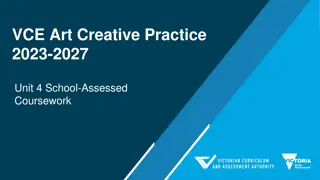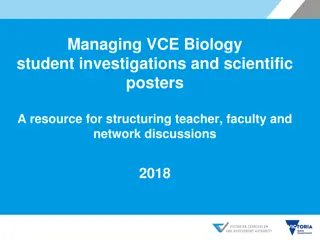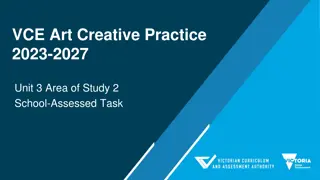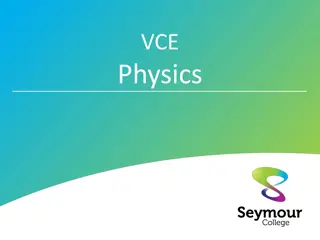Understanding the Importance of Critique in VCE Art Practice
Explore the role of critique in VCE Art Creative Practice, focusing on structuring, presenting, and utilizing feedback for artistic growth. Discover interpretive lenses such as the structural, personal, and cultural perspectives that enhance analysis and interpretation of artworks within the context of art making.
Download Presentation

Please find below an Image/Link to download the presentation.
The content on the website is provided AS IS for your information and personal use only. It may not be sold, licensed, or shared on other websites without obtaining consent from the author. Download presentation by click this link. If you encounter any issues during the download, it is possible that the publisher has removed the file from their server.
E N D
Presentation Transcript
VCE Art Creative Practice 2023-2027 The Critique
Art Creative Practice The Critique Overview This presentation will cover: The role of the Critique in VCE Art Creative Practice Units that focus on the Critique Structuring a critique Presenting the critique Using feedback from the critique
Art Creative Practice The Critique A critique is a discursive collaborative environment that is organised to engage, explore, express, present and evaluate artworks and to understand, reflect on and improve awareness of the characteristics of art making. Terms used in the Study p. 18 VCE Art Creative Practice Study Design
Art Creative Practice Study specifications: The Creative Practice Place of the Critique research and investigation experimentation and development refinement and resolution reflection and evaluation. reflecting, analysing and evaluating using critique and feedback.
Art Creative Practice The Critique Study specifications: Interpretive Lenses The Structural Lens informs the analysis and interpretation of an artwork, and its relationship with the artist and viewer or audience, through the investigation of the use of art elements and art principles, and the application of materials, techniques and processes. It also considers the stylistic qualities and symbolism evident in the artwork, and the context in which artists work and in which artworks are presented or viewed. The Personal Lens informs the analysis and interpretation of an artwork through the investigation of the personal feelings, beliefs and life experiences of the artist. The evaluation and interpretation of an artwork can be influenced by the life experiences, personal feelings and beliefs of the viewer or audience and the context in which artists work and in which artworks are presented or viewed. Structural Lens Personal Lens
Art Creative Practice The Critique Study specifications: Interpretive Lenses The Cultural Lens The Cultural Lens informs the analysis and interpretation of an artwork through the investigation of social, historical and cultural influences and representations. This includes the influence of the time and place in which the artwork is made, presented or viewed, as well as the social, historical, political, philosophical and economic influences on the practices of the artist, and how these are reflected in the artwork. Other considerations include the purpose of the artwork, and the ethnicity, gender, ethics and spiritual or secular beliefs of the artist and the viewer or audience, and how these factors influence the artwork itself and the interpretation of it. Students explore how these factors contribute to the communication of meaning and the engagement of the viewer or audience. They also consider the context in which artists work and in which artworks are presented or viewed.
Art Creative Practice Unit 2 Area of Study 3 The Critique Before finishing their artwork, students present a critique of their use of the Creative Practice. They respond to the feedback they receive from the critique to resolve their artwork. The critique can be presented by an individual student or a group of students who have collaborated to make the artwork. Outcome 3 On completion of this unit the student should be able to critically reflect on, evaluate and document their use of the Creative Practice to develop and make collaborative visual responses. Key Knowledge methods used to critique the use of the Creative Practice ways to reflect on and use feedback from a critique to refine and resolve artworks art terminology used in a critique and in documentation of the use of the Creative Practice Key Skills present a critique of the use of the Creative Practice reflect on and use feedback from a critique to resolve artworks use art terminology to document, annotate and present a critique of the use of the Creative Practice
Art Creative Practice Unit 2 Area of Study 3 Assessment documentation of the Creative Practice, in the form of critical annotations, that presents explorations in selected art forms, and demonstrates the development of the student s collaborative practice a critique of the development of personal ideas, directions, explorations, visual language, technical skills, processes and artworks. The critique can be presented orally and should be accompanied by written and visual documentation evaluation of the Creative Practice and the presentation of finished artworks evaluation of visual responses that effectively communicate social and cultural meaning
Art Creative Practice Unit 3 Area of Study 1 The Critique Before finishing their artwork, students present a critique of their use of the Creative Practice. They respond to the feedback they receive from the critique to resolve their artwork. The critique can be presented by an individual student or a group of students who have collaborated to make the artwork. Outcome 1 On completion of this unit the student should be able to develop personal ideas using research that examines one artwork and the practice of an artist, and produce at least one finished artwork using the Creative Practice. Key Knowledge methods used to present a critique of the use of the Creative Practice and finished artworks Key Skills apply appropriate methods to present a critique of the use of the Creative Practice and the finished artworks
Art Creative Practice Unit 4 Area of Study 1 The Critique Students continue to build upon the ideas begun in Unit 3 and present a critique of their use of the Creative Practice. They reflect on the feedback from their critique to further refine and resolve a Body of Work that demonstrates their use of the Creative Practice and the realisation of their personal ideas. The students present their Body of Work to an audience accompanied by documentation of their use of the Creative Practice In Unit 4, Areas of Study 1 and 2 are taught concurrently. The critique in Area of Study 1 takes place before the resolution and presentation of the Body of Work.
Art Creative Practice Unit 4 Area of Study 1 The Critique Outcome 1 On completion of this unit the student should be able to document their use of Creative Practice and present a critique to inform the refinement and resolution of a Body of Work. Key Knowledge methods used to present and critique the use of the Creative Practice feedback and reflection used to refine and resolve a Body of Work Key Skills present a critique of the use of the Creative Practice use feedback and reflection to resolve a Body of Work document, annotate and evaluate the refinement and resolution of the Body of Work, using appropriate written and visual material
Art Creative Practice Unit 3 and 4 School-assessed Task
Art Creative Practice The Critique Teaching and learning activities Familiarise yourself with all VCAA documentation Study Design; Administrative information; Advice for Teachers Outline exactly what is expected early in the year Time the Critique, giving due time to prepare the Body of Work and to respond to Critique Mentor students to minimise anxiety and normalise the process Share YouTube examples; perform workshops using your own or sample work, practice providing evaluative feedback, use the Unit 3 Area of Study 1 critique as learning opportunity, build collaborative classroom culture Determine the method/s used in the class Format - show and tell ; mini-exhibition with didactics etc.; mini-monograph with targeted questions: listening triads (speaker, questioner, and recorder). Data gathering - directed checklists, questionnaires, self evaluation, roundtable discussions, online forms
Art Creative Practice Preparing for the Critique 1. 2. 3. 4. The Critique largely sits within the Reflection and evaluation component of Creative Process. In preparing remind students to document all stages of the Creative Practice. Preparation involves thinking, planning, and writing. Students need to determine the ordering of work. Refer to their Creative Practice to identify important Interpretive Lenses the student has explored or ideas they have developed. Determine what someone needs to understand and respond to the artwork/s. Are there facts, figures or articles that they should know? 5. What why s or decisions behind the work/s would help them? What shaped or influenced their choices subject matter, technique, style, or format? Evidence of this planning should be recorded as part of their Creative Practice. 6. As students plan, they need to also consider what feedback format would be useful. For instance, using the Interpretive Lens as a model for preparing a 5-10 questions focused on seeking other s evaluative opinions about the artwork, or meanings may prompt more directed feedback.
Art Creative Practice Presenting the critique A critique requires artwork/s, relevant information, audience and opportunity for that audience to provide feedback. Students must ensure that this is documented. Use a mixture of photographs, printed didactics, dated audience list, and dated feedback sheets. The giving, receiving and recording of feedback is essential. Make sure to provide students with space, time and ways to think before they share. For instance, a think-pair-share method about a work s successes or weaknesses. Encourage the use of accurate art language in describing, evaluating and expressing opinion about artwork. This can provide another exercise in art- writing and use of the Interpretive Lenses. Depending on the nature of the presentation, these statements of questions could be spoken or written
Art Creative Practice Gathering and reflecting on feedback This is the most important aspect of the reflection and evaluation component of the Creative Practice. As the Critique finishes encourage student to start getting together and recording the information: Collect and sort documents; recall and note down conversations - taking special note of areas of interest to the audience. As students review the feedback, they must be alert for viewer s misunderstanding of their work; or recurring positive or negative points. The Interpretive Lenses could provide a scaffold for ordering feedback The reflection could start by comparing the student s thinking about the meaning and appearance of their work and it s connection with the audience. Try to understand points of divergence and what they mean for their work, or, consider how negatives could be turned into positives. The end result of reflection are plans and intentions for the next stage of a body of work resolving the artwork.
Art Creative Practice Resolving the body of work from the Critique The last stage of the critique sees the artist apply what has been learnt through the critique to their artwork. As with the rest of the process this requires the documentation in this case both visual and written. The Refinement and resolution component of Creative Practice expects evidence of the use of critical judgement and Interpretive Lenses. It is essential that students clearly identifies these and communicates the decisions they have made and why they have made them in their Body of Work. Unit 4 Area of Study 1 is only one of two assessable components related to the student s ongoing creation of a body of work. In Area of Study 2 students use Creative Practice to resolve and present their Body of Work. The formal critique is an important part of resolving the body of work, it does not replace but enriches the student s ongoing creative, critical and reflective thinking and collaborative practice.
Contact Dr Kathryn Hendy-Ekers Curriculum Manager Visual Arts, Visual Communication Design and Media E: Kathryn.Hendy-Ekers@education.vic.gov.au T: 9059 5147 M: 0438471513























